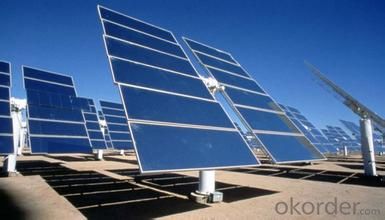Tandem Solar Cells 156mm Poly Solar Cell for 250W Solar Panel Wholesaler Price
- Loading Port:
- Shanghai
- Payment Terms:
- TT OR LC
- Min Order Qty:
- 26 watt
- Supply Capability:
- 5000 watt/month
OKorder Service Pledge
OKorder Financial Service
You Might Also Like
Specification
156x156mm 3BB Poly Solar Cells 6x6 with Sperior Quality for Solar Panel
Feature
1.High conversion efficiencies resulting in superior power output performance.
2.Outstanding power output even in low light or high temperature conditions
3.Optimized design for ease of soldering and lamination
4.Long-term stability,reliability and performance
5.Low breakage rate
6.Color uniformaity

Physical characteristic
Dimension: 156*156mm±0.5mm
Thickness: wafer(Si):200μm±20μm
Cell:240μm±40μm
Front: silver bus bars;dark blue/others silicon nitride anti reflection coating
Back: silver/aluminum bus bars;full-surface aluminum BSF
Warranty
25-years limited warranty on power output: 10 years/90%, 25 years/80%
Packaging
The solar cells are packed in cartons, and then pallet.
Shipping by sea or by air are both ok, it's up to customer’s choice.
We’d like to inquire the freight cost for customer after be informed exact quantity and destination address
Special service we offer:
give credit for 90 days for those who has good reputation and would like to establish long term relationship with us.
- Q: How do solar cells perform in cloudy or overcast conditions?
- Solar cells are less efficient in cloudy or overcast conditions compared to sunny days. The amount of sunlight reaching the cells is reduced, which reduces their ability to generate electricity. However, modern solar cell technology has improved to some extent, allowing them to still produce a certain amount of power even in cloudy conditions.
- Q: Can solar cells be used in underwater applications?
- Yes, solar cells can be used in underwater applications, but they require special design considerations.
- Q: Can solar cells be used in transportation?
- Yes, solar cells can be used in transportation. Solar-powered vehicles, such as solar cars and solar-powered boats, harness energy from the sun through photovoltaic cells to generate electricity and propel the vehicle. Additionally, solar cells can be used to power auxiliary systems in transportation, such as charging electric vehicles or providing energy for lighting and ventilation in public transportation systems. The use of solar cells in transportation helps reduce reliance on fossil fuels and contributes to a more sustainable and environmentally friendly mode of transportation.
- Q: What should I know about the Crystalline silicon photovoltaic cells?
- Crystalline silicon photovoltaic cells, known as cSi PV, are made of silicon atoms connected to one another to form a crystal lattice. This lattice comprises the solid material that forms the photovoltaic (PV) cell's semiconductors.
- Q: Can solar cells be used in water?
- Yes, solar cells can be used in water. Some solar panels are specifically designed to be used in water environments, such as floating solar panels used in reservoirs, lakes, and other bodies of water. These panels are waterproof and can efficiently generate electricity even when partially submerged.
- Q: Can solar cells be used to power remote transportation systems?
- Yes, solar cells can be used to power remote transportation systems. Solar cells are a reliable and sustainable source of renewable energy that can be installed on vehicles or infrastructure to provide power for electric motors, batteries, or other components. This allows remote transportation systems such as electric cars, boats, or drones to operate efficiently without relying on fossil fuels or traditional power grids, making them more environmentally friendly and cost-effective in remote areas.
- Q: What is the role of solar cells in powering electric fences?
- Solar cells play a crucial role in powering electric fences by converting sunlight into electrical energy. These cells, also known as solar panels, capture sunlight and generate a direct current (DC) that is stored in a battery. The stored energy is then used to power the electric fence, providing a constant source of electricity without the need for grid connection or fossil fuels.
- Q: What is the impact of solar cells on reducing greenhouse gas emissions?
- Solar cells have a significant impact on reducing greenhouse gas emissions as they generate clean and renewable energy from sunlight, without emitting any greenhouse gases. By replacing fossil fuel-based electricity generation, solar cells help reduce the carbon dioxide and other harmful emissions that contribute to climate change. This transition towards solar energy plays a crucial role in mitigating global warming and creating a more sustainable future.
- Q: What is the role of batteries in solar cell systems?
- The role of batteries in solar cell systems is to store the excess energy generated by the solar panels during the day, so it can be used during periods of low sunlight or at night. This helps ensure a continuous and reliable power supply from solar energy.
- Q: Can solar cells be used on spacecraft?
- Yes, solar cells can be used on spacecraft. In fact, solar cells are commonly utilized on spacecraft to generate electricity by converting sunlight into usable energy. This provides a reliable and renewable source of power for various systems and instruments onboard the spacecraft.
Send your message to us
Tandem Solar Cells 156mm Poly Solar Cell for 250W Solar Panel Wholesaler Price
- Loading Port:
- Shanghai
- Payment Terms:
- TT OR LC
- Min Order Qty:
- 26 watt
- Supply Capability:
- 5000 watt/month
OKorder Service Pledge
OKorder Financial Service
Similar products
Hot products
Hot Searches
Related keywords


























